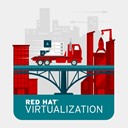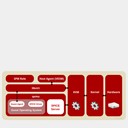The beta release of Red Hat Virtualization 4.2 includes a number of new and updated features to help organizations streamline and automate operations.
While there are numerous new features and bug fixes, there is not enough room to list them all here. However, I would like to highlight a few of the additions that make the RHV 4.2 beta remarkable.
| Brand | Red Hat |
| Product Type | INFRASTRUCTURE AND MANAGEMENT |
| Version | Red Hat Virtualization 4.2 |
| License Type | 1 year Subscription |
| System Requirements | "The minimum and recommended hardware requirements outlined here are based on a typical small to medium sized installation. The exact requirements vary between deployments based on sizing and load. The Red Hat Virtualization Manager runs on Red Hat Enterprise Linux CPU: A quad core CPU or multiple dual core CPUs. Memory:16 GB of system RAM. Hard Disk: 50 GB of locally accessible, writable, disk space. Network Interface: 1 Network Interface Card (NIC) with bandwidth of at least 1 Gbps." |
| Feature 01 | The new metrics and logging solution is built around the Elasticsearch, Fluentd, and Kibana (EFK) stack, the same stack used by Red Hat OpenShift Container Platform. The new metrics store provides much more functionality and details on the RHV environment than was available previously. |
| Feature 02 | When RHV 4.0 was released in August of 2016, it showcased the new dashboard tab as a new way of viewing essential resource utilization within RHV as well as how virtualization administrators will interact with RHV in the future. RHV 4.2 has made significant strides in furthering these UI updates. |
| Feature 03 | The RHV 4.2 release provides a new virtual machine type called High Performance when configuring VMs. It is capable of running a VM with the highest possible performance, as close to bare metal as possible. This greatly streamlines the process of configuring the characteristics of a virtual machine over the previous manual-only methods. |
| Feature 04 | The Ceph iSCSI target has been tested and certified as a storage domain for virtual machines. This provides more infrastructure and deployment choices for engineers and architects. |
| Feature 05 | Open Virtual Network (OVN) has been integrated with Red Hat Virtualization to deliver a native SDN solution through the use of Open vSwitch. It provides automated management of network infrastructure, a Neutron compatible API for external network providers, and network self-service for users, which liberates network administrators from infrastructure requests. |
| Feature 06 | This is a native site-to-site failover solution. Instead of integrating with a specific storage vendor, it depends on storage at both sites that can be replicated reliably and consistently. Under the covers, Ansible is used extensively to automate the failover and fallback process. |
| Feature 07 | Example: Cisco ACI Integration. Cisco ACI provides overlay protocols that support both physical and virtual hosts in the same logical network even while running Layer 3 routing. This integration provides additional options for customers, especially those that use Cisco ACI as part of their infrastructure. |
While there are numerous new features and bug fixes, there is not enough room to list them all here. However, I would like to highlight a few of the additions that make the RHV 4.2 beta remarkable.



